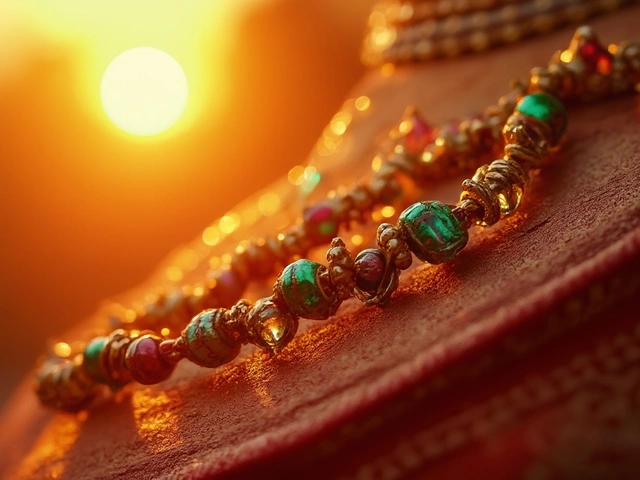So, you've got a red thread bracelet, and you're wondering when it's the right time to take it off. You're not alone. You've probably seen these little bands on wrists more times than you can count, and each carries its own story and reason. Depending on who you ask, you'll get all sorts of answers about the significance behind the thread.
From offering protection and good luck to serving as a reminder of a special promise or event, these threads are much more than just an accessory. But like any tradition, there are times when it feels appropriate to remove it, while for others, they never have a reason to part with theirs. So, let’s clear up when you might want to consider bidding farewell to your red thread.
- Origin and Meaning
- Significance Across Cultures
- When to Remove
- How to Remove Respectfully
- Common Misunderstandings
Origin and Meaning
The humble red thread is more than just a piece of string; it's steeped in history and cultural heritage. It's been around for centuries, cutting across various religious and spiritual practices. The most famous use probably hails from Hindu and Buddhist traditions, where it's known as 'kalava' in Hinduism or 'raksha sutra' and is tied during ceremonies for blessings and protection.
In these traditions, wearing a red thread symbolizes a safeguard against negative energies. It's often tied around the wrist during religious events like weddings, births, or sacred threads ceremonies, known in Hinduism as 'Upanayana.' It's essentially a physical manifestation of a protective mantle, kind of like having your guard up but in a spiritual sense.
Global Significance
But hey, it's not just confined to the Indian subcontinent. In Kabbalah, a branch of Jewish mysticism, the red thread is worn on the left wrist—you might have seen celebrities donning these. It's tied while reciting a prayer at Rachel's tomb in Israel, symbolizing protection and warding off what's known as the 'evil eye.'
Interestingly, in East Asian cultures, there's the 'red thread of fate' belief, suggesting that this mystical string ties together people who are destined to meet, regardless of time, place, or circumstance.
So whenever you see someone sporting one of these threads, know that it carries layers of history, tradition, and personal story. It's like a global badge that connects a myriad of beliefs and practices across the world.
Significance Across Cultures
Red thread bracelets, also simply called red thread, aren't confined to one culture or belief system. They're a global phenomenon, capturing a multitude of meanings depending on where and who you ask. Their universal presence underscores a shared human desire for protection, luck, and connection.
Hindu Tradition
In Hindu culture, the red thread is called 'Kalava' or 'Mouli'. It's given when someone participates in a prayer ceremony or ‘puja.’ Sometimes tied by a priest, it’s meant to offer protection and signify blessings from the divine. The thread is often worn until it naturally falls off, symbolizing that the blessings have taken effect.
Kabbalistic Practice
In the Jewish Kabbalistic tradition, the red string is believed to provide protection against the 'evil eye'. This interpretation mainly hails from the influence of figures like Rachel in the Torah. The thread is typically tied on the left wrist, as this side is believed to be the receiving side of energy, and thus more vulnerable.
Budai Rizuru Custom
Moving to East Asia, in some Buddhist and Taoist practices, such threads are often called 'pixian' and are rooted in ancestral worship and temple blessings. They symbolize an unseen bond between the wearer and the spiritual guidance offered by their ancestors or local deities.
Scientific Trivia
| Cultural Group | Reason for Wearing |
|---|---|
| Hindu | Divine protection through rituals |
| Kabbalah | Protection against the evil eye |
| East Asian | Ancestral worship, divine connection |
As fascinating as these traditions are, what's important to remember is that while the meaning of the red thread might vary, at its core, it serves as a universal symbol of protection and good fortune. Its presence in various cultures highlights our shared human experiences despite diverse traditions.

When to Remove Your Red Thread Bracelet
There's a lot of talk around when's the right time to take off that red thread bracelet. Different traditions and personal beliefs have various guidelines.
Timing Based on Traditions
In Hinduism, the red thread is often tied during religious ceremonies as a symbol of protection and blessings. It is commonly advised to remove it when it naturally falls off, signifying that its protective duties are complete. In Kabbalah, the red thread bracelet is worn to fend off the 'evil eye,' and it's typically removed once it's sufficiently worn out or frayed.
"The true essence of removing the thread is not a fixed moment but when your inner journey takes you to a place of fulfillment," says renowned spiritual guide Anjali Verma.
Personal Beliefs and Practical Reasons
Some folks take off their red bracelet at significant life events or the beginning of a new journey, symbolizing a fresh start. Others might do so after achieving a personal milestone or upon the advice of a spiritual mentor.
Practically, it might also come down to comfort. If it gets too tight or uncomfortable, it might be the universe's way of saying it's time to let it go.
General Practices
- Observe any unraveling or fraying, indicating natural wear and tear as a cue.
- Consult with your religious or spiritual advisor if following specific faith-based guidelines.
- Trust your instincts. Assess whether its symbolic importance has reached its course.
In the end, whether it’s about tradition or personal comfort, knowing when to remove your red thread bracelet is as much about understanding its purpose as it is about following specific rules. It's all about what feels right for you in your heart and mind.
How to Remove Respectfully
Alright, you've decided it's time to let your red thread go. But hold on, there's more to it than just snipping it off. If you're following a particular tradition, it's important to do it the right way to respect its significance.
1. Know Why You're Removing It
First things first, understand why you're taking it off. Is it because it's worn out, you feel it's served its purpose, or does a specific tradition call for its removal after a certain period?
2. The Right Time
Many believe there's a certain auspiciousness to timing. For instance, some prefer removing it during a full moon or at the start of a new year, as it symbolizes new beginnings. Always check if your tradition has a specific time outlined.
3. Use Scissors, Not Force
Cutting the thread with scissors is often recommended, as it signifies a clean break from whatever was being symbolized. Don’t yank it off; it could fray the significance!
4. Disposal Matters
Don't just toss it in the trash. Burying it or placing it in a natural body of water is common practice among some cultures. This is because these methods symbolize returning the protection or energy to the earth.
- Bury it in your garden as a sign of grounding.
- Offer it to a river or ocean, letting the water cleanse and carry away the past.
If you're following a certain tradition, there might be additional or alternative methods, so it's always fascinating to ask around or do some digging into your specific practice!

Common Misunderstandings
There's a lot of chatter and assumptions floating around about red thread bracelets. Let’s demystify some of these common misunderstandings to help you rock your red thread with confidence.
It's Just a Fashion Statement
First off, many think that these threads are just trendy bracelets people wear for show. While they do look cool, they carry much deeper meanings rooted in culture and spirituality. Whether it's the Hindu practice or the Kabbalistic tradition, each thread is more than a chic accessory.
One Size Fits All Meaning
Another common misunderstanding is the assumption that the significance is uniform across the board. But in reality, the meaning can vary greatly depending on cultural backgrounds and personal beliefs. For example, in Hinduism, a red thread can be tied during religious ceremonies for protection, while in Kabbalah, it's usually worn for good luck and warding off the evil eye.
Never Remove the Thread
Some people believe that once you wear a red thread, it must never be removed. This isn’t universally true. The timing for removing a red thread often depends on personal intuition or specific cultural guidelines. Certain traditions say you should let it fall off naturally, while others allow for removal once a particular event or need has passed.
One Red Thread Across All Cultures
Not all red threads are created equal! You might be surprised to learn that various communities have different methods for making and wearing these bracelets. In some cultures, specific rituals are involved in tying the thread, making it custom-tailored to each individual.
With these clarifications, you'll be better equipped to understand and appreciate the multifaceted significance of wearing a red thread. Whether it's for personal significance or a cultural connection, knowing the background helps you make your own experience more meaningful.



